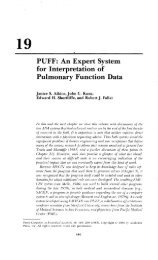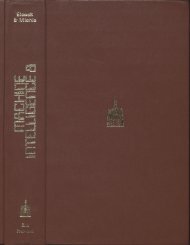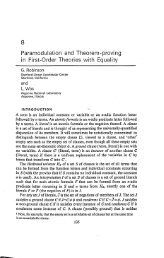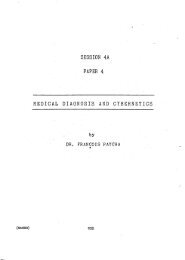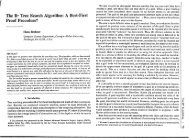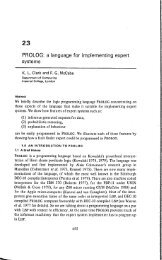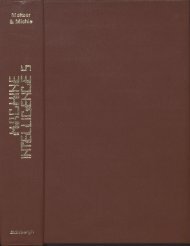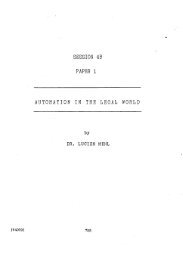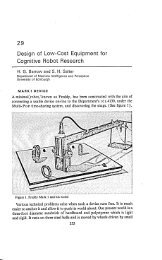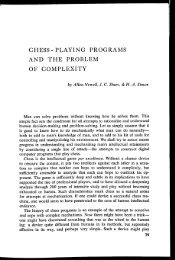Theorem-proving by resolution as a basis for question ... - AITopics
Theorem-proving by resolution as a basis for question ... - AITopics
Theorem-proving by resolution as a basis for question ... - AITopics
- No tags were found...
Create successful ePaper yourself
Turn your PDF publications into a flip-book with our unique Google optimized e-Paper software.
11<strong>Theorem</strong>-Proving <strong>by</strong> Resolution <strong>as</strong> aB<strong>as</strong>is <strong>for</strong> Question-Answering SystemsCordell GreenStan<strong>for</strong>d Research InstituteMenlo Park, Cali<strong>for</strong>niaABSTRACTThis paper shows how a <strong>question</strong>-answering system can be constructed usingfirst-order logic <strong>as</strong> its language and a <strong>resolution</strong>-type theorem-prover <strong>as</strong> itsdeductive mechanism. A working computer-program, Q A3, b<strong>as</strong>ed on theseide<strong>as</strong> is described. The per<strong>for</strong>mance of the program compares favorably withseveral other general <strong>question</strong>-answering systems.1. QUESTION ANSWERINGA <strong>question</strong>-answering system accepts in<strong>for</strong>mation about some subject are<strong>as</strong>and answers <strong>question</strong>s <strong>by</strong> utilizing this in<strong>for</strong>mation. The type of <strong>question</strong>answeringsystem considered in this paper is ideally one having the followingfeatures:1. A language general enough to describe any re<strong>as</strong>onable <strong>question</strong>answeringsubjects and express desired <strong>question</strong>s and answers.2. The ability to search efficiently the stored in<strong>for</strong>mation and recognizeitems that are relevant to a particular query.3. The ability to derive an answer that is not stored explicitly, but that isderivable <strong>by</strong> the use of moderate ef<strong>for</strong>t from the stored facts.4. Interactions between subject are<strong>as</strong>; <strong>for</strong> example, if the system h<strong>as</strong>facts about Subject A and Subject B, then it should be able to answer a<strong>question</strong> that requires the use of both sets of facts.5. Capability of allowing the user to add new facts or replace old factsconveniently.This paper argues the c<strong>as</strong>e <strong>for</strong> <strong>for</strong>mal methods to achieve such a system andpresents one particular approach in detail. A natural language facility is notone of the properties sought after or discussed (although Coles, 1968, h<strong>as</strong>183
DEDUCTIVE INFORMATION RETRIEVALadded to the program described here a translator from a subset of English tofirst-order logic).The name '<strong>question</strong>-answering system' requires clarification. The systemdescribed above might be named an 'advice taker' or a 'multi-purpose problem-solvingsystem' or 'general problem-solving system'. McCarthy (1958)proposed using <strong>for</strong>mal languages and deduction to construct such a system,and suggested allowing the user to give hints or advice on how to answer a<strong>question</strong>; he referred to the proposed system <strong>as</strong> an 'advice taker'. Researchon 'multi-purpose' or 'general problem-solving' tends to differ from <strong>question</strong>answering<strong>as</strong> described above <strong>by</strong> placing more emph<strong>as</strong>is on solving deeper,more difficult problems and less emph<strong>as</strong>is on user interaction, <strong>for</strong>mality, andefficient retrieval of relevant facts from a large data b<strong>as</strong>e. The situation isfurther confused <strong>by</strong> the use of '<strong>question</strong>-answering' to refer sometimes tonatural language systems, sometimes to in<strong>for</strong>mation retrieval systems havinglittle deductive ability, and sometimes to systems with deductive abilitylimited to the propositional calculus.It is important to emph<strong>as</strong>ize the distinction between general versus specialpurpose<strong>question</strong>-answering. If the cl<strong>as</strong>s of <strong>question</strong>s <strong>as</strong>ked of a system issmall, completely specified in advance, and concerned with a particularsubject area, such <strong>as</strong> the <strong>question</strong>-answering system of Green, Wolf, Chomsky,and Laughery (1963) concerned with b<strong>as</strong>eball, or that of Lindsay (1963)concerned with family relations, then we shall call such a system 'specialpurpose'.Frequently the goal in designing a special-purpose system is toachieve good per<strong>for</strong>mance, me<strong>as</strong>ured in terms of running speed and memoryutilization. In this c<strong>as</strong>e the best approach may be first to construct a specialdata b<strong>as</strong>e or memory that is optimized <strong>for</strong> that subject area and <strong>question</strong>cl<strong>as</strong>s, and then to write special <strong>question</strong>-answering subroutines that areoptimized <strong>for</strong> the particular data b<strong>as</strong>e and <strong>question</strong> cl<strong>as</strong>s. On the otherhand, a 'general' <strong>question</strong>-answering system is one that allows arbitrarysubject are<strong>as</strong>, arbitrary <strong>question</strong>s, and arbitrary interactions between subjectare<strong>as</strong> during the process of answering a <strong>question</strong>. This taper describes a rather<strong>for</strong>mal approach to designing a general <strong>question</strong>-answering system. A precisename <strong>for</strong> our system is 'a general, <strong>for</strong>mal, deductive, <strong>question</strong>-answeringsystem.'2. THEOREM-PROVINGThe use of a theorem-prover <strong>as</strong> a <strong>question</strong>-answerer can be explained verysimply. The <strong>question</strong>-answerer's knowledge of the world is expressed <strong>as</strong> a setof axioms, and the <strong>question</strong>s <strong>as</strong>ked it are presented <strong>as</strong> theorems to be proved.The process of <strong>proving</strong> the theorem is the process of deducing the answer tothe <strong>question</strong>. For example, the fact 'George is at home', is presented <strong>as</strong> theaxiom, AT(George, home). The <strong>question</strong> 'Is George at home?' is presented<strong>as</strong> the conjectured theorem, AT(George, home). If this theorem is provedtrue, the answer is yes. (In this simple example the theorem is obviously true184
GREENsince the axiom is the theorem.) The theorem-prover can also be used to findor construct an object satisfying some specified conditions. For example, the<strong>question</strong> 'Where is George?' requires finding the place x satisfying AT (George,x). The theorem-prover is embedded in a system that controls the theoremprover,manages the data b<strong>as</strong>e, and interacts with the user. These ide<strong>as</strong> areexplained in more detail below.Even though it is clear that theorem-<strong>proving</strong> can be used <strong>for</strong> <strong>question</strong>answering,why should one use these very <strong>for</strong>mal methods? <strong>Theorem</strong>-<strong>proving</strong>may be a good approach to the achievement of generality <strong>for</strong> several re<strong>as</strong>ons:1. The language is well defined, unambiguous, and rather general, sothat one may hope to describe many desired subjects, <strong>question</strong>s, oranswers.2. The proof procedure used allows all possible interaction among theaxioms and is logically 'complete' that is, if a theorem is a logicalconsequence of the axioms, then this procedure will find a proof,given enough time and space. This completeness property is importantsince several general <strong>question</strong>-answering programs have resulted inincomplete deductive systems, even in the practical sense of beingunable to answer some simple types of <strong>question</strong>s that are short,re<strong>as</strong>onable deductions from the stored facts — <strong>for</strong> example, theauthor's Q Al (Green and Raphael 1968), Raphael's SIR (1964),Slagle's DEDUCOM (1965), and Safier's SIMPLE SIMON (1965).(However, the fact that we use a first-order logic theorem-proverdoes impose certain important restrictions discussed in section 5.)3. The theorem-prover is subject-independent, so that to describe a newsubject or modify a previous description of a subject, only the axiomsneed to be changed, and it is not necessary to make any changes in theprogram.4. Formal techniques such <strong>as</strong> those developed here may be generallyvaluable to the field of artificial intelligence. The use of a <strong>for</strong>malframework can lead to insights and generalizations that are difficult todevelop while working with an ad hoc system. A common, welldefinedframework facilitates communication between researchers,and helps to unify and relate diverse results that are difficult to compare.5. <strong>Theorem</strong>-provers are becoming more efficient. Even though thetheorem-<strong>proving</strong> method used is theoretically complete, in practice itsability to find proofs is limited <strong>by</strong> the availability of computer timeand storage space. However, the method of 'Resolution' (Robinson1965), used <strong>by</strong> the program described here, h<strong>as</strong> been developed to thepoint of having several good heuristics. Further improvements intheorem-<strong>proving</strong> are very likely, and, hopefully, the improvementswill carry over into corresponding improvements in <strong>question</strong>-answering.185
DEDUCTIVE INFORMATION RETRIEVALIt should be possible to communicate precisely new theorem-<strong>proving</strong>results to other researchers, and it is relatively e<strong>as</strong>y to communicateprecisely particular <strong>for</strong>malizations or axiomatizations of subjects.3. EXTENDING THEOREM-PROVING TO QUESTION-ANSWERINGThis section describes, in general, how <strong>question</strong>s can be <strong>as</strong>ked in first-orderlogic, and how answers can be generated. Examples illustrating these methodsare presented. The discussion in this section and the following two <strong>as</strong>sumesthat the reader is somewhat familiar with logic and automatic theorem<strong>proving</strong>.An introduction to automatic theorem-<strong>proving</strong> is given in Cooper(1966) and Davis (1963). The theorem-<strong>proving</strong> methods mentioned in thispaper use the Resolution Principle proposed <strong>by</strong> J. A. Robinson (1965 and1967). Additional strategies <strong>for</strong> using the Resolution principle are presented<strong>by</strong>Wos etal. (1964,1965 and 1967). This l<strong>as</strong>t paper defines terms the 'ExtendedSet of Support' strategy, 'degree', and 'singly connectedness', that are usedin section 4.The explanation of <strong>question</strong>-answering given in this section will be illustratedprimarily <strong>by</strong> the techniques used in a working <strong>question</strong>-answeringprogram called Q A3. It is programmed in LISP on the SDS 940 computer,operating in the time-sharing mode. The user works at a teletype, enteringstatements and <strong>question</strong>s, and receiving replies. The notation in this paper isslightly different from the actual computer input and output, <strong>as</strong> the characterset available on the teletype does not contain the symbols we use here. Q A3is an outgrowth of Q A2 (Green and Raphael 1968), an earlier system, but issomewhat more sophisticated and practical, and is now being used <strong>for</strong> severalapplications.1. Types of <strong>question</strong>s and answersFacts are presented <strong>as</strong> statements of first-order logic. The statement is preceded<strong>by</strong> STATEMENT to indicate to the program that it is a statement. Thesestatements (axioms) are automatically converted to clauses and stored in thememory of the computer. The memory is a list structure indexed <strong>by</strong> thepredicate letters, function symbols, and constant symbols occurring in eachclause. A statement can be a very specific fact such <strong>as</strong>STATEMENT: COLO R(book, red)corresponding to the common attribute-object-value triple. A statement canalso be a more general description of relations, such <strong>as</strong>:STATEMENT: (V x)(V A)(V B)[A gB A X E A=x e B]meaning that if A is a subset of B and if x is an element of A, then x is anelement of B.Questions are also presented <strong>as</strong> statements of first-order logic. QUESTIONis typed be<strong>for</strong>e the <strong>question</strong>. This <strong>question</strong> becomes a conjecture and Q A3186
GREENattempts to prove the conjecture in order to answer YES. If the conjectureis not proved, QA3 attempts to prove the negation of this <strong>question</strong> in order toanswer NO. The theorem-prover attempts a proof <strong>by</strong> refutation. During theprocess of searching <strong>for</strong> a proof, clauses that may be relevant to a proof areextracted from memory and utilized <strong>as</strong> axioms. If the <strong>question</strong> is neitherproved nor disproved, then a NO PROOF FOUND answer is returned.ANSWER indicates an answer.We now present a very simple dialogue with QA3. The dialogue illustrates a'yes' answer, a 'no' answer, and an 'or' answer. Questions 4, 7, and 8 belowillustrate <strong>question</strong>s where the answer is a term generated <strong>by</strong> the proofprocedure. These kinds of answers will be called 'constructive' answers.1. The first fact is 'Smith is a man.'STATEMENT: MAN(Smith)OKThe OK response from QA3 indicates that the statement is accepted, convertedto a clause, and stored in memory.2. We <strong>as</strong>k the first <strong>question</strong>, 'Is Smith a man?'QUESTION: MAN(Smith)ANSWER: YES3. We now state that 'Man is an animal,' or, more precisely, 'If x is aman then x is an animal.'STATEMENT: (Vx)[MAN(x)ANIMAL(x)]OK4. We now <strong>as</strong>k 'Who is an animal?' This <strong>question</strong> can be restated <strong>as</strong>'Find some y that is an animal' or 'Does there exist a y such that yis an animal? If so, exhibit such a y.'QUESTION: (3y)ANIMAL(y)ANSWER: YES, y=SmithThe YES answer indicates that the conjecture (3y)ANIMAL(y) h<strong>as</strong> beenproved (from statements 1 and 3 above). 'y = Smith' indicates that 'Smith' isan instance of y satisfying A NIMAL(y)—i.e., ANIMAL(Smith) is atheorem.5. Fact: A robot is a machine.STATEMENT: (V.Ic)[ROBOT(x)MACHINE(x)]OK6. Fact: Rob is a robot.STATEMENT: ROBOT(Rob)OK187
DEDUCTIVE INFORMATION RETRIEVAL7. Fact: No machine is an animal.STATEMENT: (Vx)[MACHINE(x)ANIMAL(x)]OK8. The <strong>question</strong> 'Is everything an animal?' is answered NO.A counterexample is exhibited — namely, Rob the robot.QUESTION: (V x)ANIMAL(x)ANSWER: NO, x= RobThe answer indicates that A NI M AL(Rob) is a theorem. Note that a NOanswer produces a counterexample <strong>for</strong> the universally quantified variable x.This is the dual of the construction of a satisfying instance <strong>for</strong> an existentiallyquantified variable in a <strong>question</strong> answered YES.9. Fact: Either Smith is at work or Jones is at work.STATEMENT: AT (Smith,work)V AT (Jones,work)OK10. Question: 'Is any one at work?'QUESTION: (3x)(AT(x,work))ANSWER: YES, x= Smithor x =JonesFrom the previous statement it is possible to prove that someone is at work,although it is not possible to specify a unique individual.Statements, <strong>question</strong>s, and answers can be more complex so that theircorresponding English <strong>for</strong>m is not so simple. Statements and <strong>question</strong>s canhave many quantifiers and can contain functions. The answer can also containfunctions. Consider the <strong>question</strong> 'Is it true that <strong>for</strong> all x there exists a ysuch that P(x,y) is true ?', where P is some predicate letter. Suppose QA3 isgiven the statement,11. STATEMENT: (V z)P(z,f(z))where .1 is some function. We <strong>as</strong>k the <strong>question</strong>12. QUESTION: (V x)(3y)P(x,y)ANSWER: YES, y=f(x)Notice that the instance of y found to answer the <strong>question</strong> is a function of x,indicating the dependence of y on x. Suppose that instead of statement 11above, QA3 h<strong>as</strong> other statements about P. An answer to <strong>question</strong> 12 might beANSWER: NO, x=awhere a is some instance of x that is a counterexample.The term(s) that is the answer can be either a constant, a function, avariable, or some combination thereof. If the answer is a constant or a knownfunction, then the meaning of the answer is clear. However, the answer may188
GREENbe a Skolem function generated <strong>by</strong> dropping existential quantifiers. In thisc<strong>as</strong>e, the answer is an object <strong>as</strong>serted to exist <strong>by</strong> the existential quantifier thatgenerated the Skolem function. To know the meaning of this Skolem function,the system must exhibit the original input statement that caused the productionof the Skolem function. Free variables in clauses correspond to universallyquantified variables, so if the answer is a free variable, then any term satisfiesthe <strong>for</strong>mula and thus answers the <strong>question</strong>.Two more types of answers are NO PROOF FOUND and INSUFFI-CIENT INFORMATION. Suppose the theorem-prover fails to provesome conjecture and also fails to disprove the conjecture. If the theoremproverruns out of time or space during either the attempted 'yes' proof or theattempted 'no' proof, then there is the possibility that some proof is possibleif more time or space is available. The answer in this c<strong>as</strong>e is NO PROOFFOUND.Now suppose both proof attempts fail without exceeding any time orspace limitations. The theorem-<strong>proving</strong> strategy is complete so that if notime or space limitation halts the search <strong>for</strong> a proof and the conjecture is alogical consequence of the axioms, then a proof will be found. So we knowthat neither a 'yes' nor a 'no' answer is possible from the given statements.The answer returned is INSUFFICIENT INFORMATION. Forexample, suppose QA3 h<strong>as</strong> no statements containing the predicate letter 'R':QUESTION: (3x)R(x)The negated <strong>question</strong> is the clause { —R(x)}, and no other clauses in thememory of QA3 can resolve with it. Thus the system will respondANSWER: INSUFFICIENT INFORMATION.2. Constructing answersThe Resolution method of <strong>proving</strong> theorems allows us to produce correctconstructive answers. This means that if, <strong>for</strong> example, (3x)P(x)is a theoremthen the proof procedure can find terms t1, t2,. t„ such that P(t2) V P(t2) V. . . V P(t,i)is a theorem.First, we shall present some examples of answer construction. After theseexamples we shall show how a proof <strong>by</strong> <strong>resolution</strong> can be used to generate ananswer.Examples of answer construction will be explained <strong>by</strong> means of theANSWER predicate used <strong>by</strong> QA3 to keep track of instantiations. Considerthe <strong>question</strong>QUESTION: (3y)ANIMAL(y)which is negated to produce the clause{—,ANIMAL(y)).The special literal, ANSWER(y), is added to this clause to give{— ANIMAL(y) V ANSWER(y)}.189
DEDUCTIVE INFORMATION RETRIEVALThe proof process begins with this clause. When the literal ANIMAL(x) isresolved against the literal ,,,ANIMAL(y), the term y is instantiated toyield the term x. In the new clause resulting from this <strong>resolution</strong>, the argumentof ANSWER is then x. In the next <strong>resolution</strong> the argument of ANSWERbecomes Smith. We list the complete modified proof that terminates with theclause{ANSWER(Smith)}.1. {—ANIMAL(y) V ANSWER(y)} Modified negation of the <strong>question</strong>.2. { MAN(x)V ANIMAL(x)}3. { MAN(x)V ANSWER(x)}4. {MAN(Smith)}5. {ANSWER(Smith)}Axiom fetched from memory.From resolving 1 and 2.Axiom fetched from memory.`Contradiction' from 3 and 4 <strong>for</strong>y=Smith.The argument of the ANSWER predicate is the instance of y — namely,Smith— that answers the <strong>question</strong>. Q A3 returnsANSWER: YES, y=Smith.This answer means, <strong>as</strong> will be explained later, thatANIMAL(Smith)is a theorem.The ANSWER literal is added to each clause in the negation of the<strong>question</strong>. The arguments of ANSWER are the existentially quantifiedvariables in the <strong>question</strong>. When a new clause is created, each ANSWERliteral in the new clause is instantiated in the same manner <strong>as</strong> any otherliteral from the parent clause. However, the ANSWER literal is treatedspecially; it is considered to be invisible to <strong>resolution</strong> in the sense that noliteral is resolved against it and it does not contribute to the length (size) ofthe clause containing it. We call a clause containing only ANSWER literalsan `answer clause.' The search <strong>for</strong> an answer (proof) successfully terminateswhen an answer clause is generated. The addition of the ANSWERpredicate to the clauses representing the negation of the theorem does notaffect the completeness of this modified proof procedure. The theoremprovergenerates the same clauses, except <strong>for</strong> the ANSWER predicate, <strong>as</strong>the conventional theorem-prover. Thus in this system an answer clause isequivalent to the empty clause that establishes a contradiction in a conventionalsystem.An answer clause specifies the sets of values that the existentially quantifiedvariables in the <strong>question</strong> may take in order to preserve the provability of the<strong>question</strong>. The precise meaning of the answer will be specified in terms of a<strong>question</strong> Q that is proved from a set of axioms B={B1,B2,. .190
GREENAs an example illustrating some difficulties with Skolem functions, let theaxioms B consist of a single statement,STATEMENT: (V z)(3w)P(z,w)Suppose this is converted to the clauseIP(z,f(z))} ,where f(z) is the Skolem function due to the elimination of the quantifier(3w). We <strong>as</strong>k the <strong>question</strong> Q,QUESTION: (V y)(3x)P(y,x).The negation of the <strong>question</strong> is — Q,(3y)(VThe clause representing — Q is{—P(b,x)} ,where b is the constant (function of no variables) introduced <strong>by</strong> the eliminationof (3y). The proof, obtained <strong>by</strong> resolving these two clauses, yields theanswer clause{ANS WE R(f(b))}The Skolem Function b is replaced <strong>by</strong> y, and the answer printed out isANSWER: YES, x=f(y). ( 1 )At present in QA 3 the Skolem function f(y) is left in the answer. To helpsee the meaning of some Skolem function in the answer, the user can <strong>as</strong>k thesystem to display the original statement that, when converted to clauses,caused the generation of the Skolem function.As an illustration, consider the following interpretation of the statementand <strong>question</strong> of this example. Let P(u,v) be true if u is a person at work and vis this person's desk. Then the statement (V z)(3w)P(z,w) <strong>as</strong>serts that everyperson at work h<strong>as</strong> a desk, but the statement does not name the desk. TheSkolem function f(z) is created internally <strong>by</strong> the program during the processof converting the statement (Vz)( 3w)P(z,w) into the clause {P(z,f(z))} .The function f(z) may be thought of <strong>as</strong> the program's internal name <strong>for</strong> z'sdesk. (The term f(z) could perhaps be written more meaningfully in terms ofthe descriptive operator i <strong>as</strong> `iw.P(z,w),' i.e., 'the w such that P(z,w)',although w is not necessarily unique.)The <strong>question</strong> (V y)(9x)P(y,x) <strong>as</strong>ks if <strong>for</strong> every person y there exists acorrespondingdesk. The denial of the <strong>question</strong>, (3y)(Vx) -,P(y,x), postulatesthat there exists a person such that <strong>for</strong> all x, it is not the c<strong>as</strong>e that x is his desk.The Skolem function of no arguments, b, is also created internally <strong>by</strong> the191
DEDUCTIVE INFORMATION RETRIEVALprogram <strong>as</strong> it generates the clause {—P(b,x)}. The function b is thus theprogram's internal name <strong>for</strong> the hypothetical person who h<strong>as</strong> no desk.The one-step proof merely finds that b does have a desk, namely f(b). Theuser of the system does not normally see the internal clause representationsunless he specifically requests such in<strong>for</strong>mation. If the term f(b) that appearsin the answer clause were given to the user <strong>as</strong> the answer, e.g. YES, x=f(b),the symbols fand b would be meaningless to him. But the program remembersthat b corresponds toy, so b is replaced <strong>by</strong> y, yielding a slightly more meaningfulanswer, YES, x=f(y). The user then knows that y is the same y he usedin the <strong>question</strong>. The significance of the Skolem function f is slightly moredifficult to express. The program must tell the user where f came from. Thisis done <strong>by</strong> returning the original statement (V z)P(z,f(z)) to the user (alternatively,the descriptive operator could be used to specify thatf(z)isiw.P(z,w)).As a rule, the user remembers, or h<strong>as</strong> be<strong>for</strong>e his eyes, the <strong>question</strong>, but thespecific <strong>for</strong>m of the statements (axioms) is <strong>for</strong>gotten. In this very simpleexample the meaning off is specified completely in terms of the <strong>question</strong>predicate P, but in general the meanings of Skolem functions will be expressedin terms of other predicates, constants, etc.We will now show how to construct an 'answer statement', and then we willprove that the answer statement is a logical consequence of the axiom clauses.The user may require that an answer statement be exhibited, in order betterto understand a complicated answer.Consider a proof of <strong>question</strong> Q from the set of axioms B. {B1,B2, BO •B logically implies Q if and only if B A Q is unsatisfiable. The statementB A Q can be written in prenex <strong>for</strong>m P M(Y, X), where P is the quantifierprefix, M(Y, X) is the matrix, Y= {y ,y2,.. y„} is the set of existentiallyquantified variables in P, and X= {x1,x2,.. xe} is the set of universallyquantified variables in P.Eliminating the quantifier prefix P <strong>by</strong> introducing Skolem functions toreplace existential quantifiers and dropping the universal quantifiers producesthe <strong>for</strong>mula M(U, X). Here U is the set of terms { ti1,u2, . uu}, such that<strong>for</strong> each existentially quantified variable yi in P, ui is the correspondingSkolem function applied to all the universally quantified variables in Ppreceding yi. Let M(U, X) be called S. The statement B A Q is unsatisfiableif and only if the corresponding statement S is unsatisfiable. Associated withS is a Herbrand Universe of terms H that includes X, the set of free variablesof S. If = { tilxi, t242, . t„/x„ } represents a substitution of terms t1, t2,t„ from H <strong>for</strong> the variables xi, x2, . x„, then SO denotes the instance of Sover H <strong>for</strong>med <strong>by</strong> substituting the terms ti, t2, t. from H <strong>for</strong> the correspondingvariables xi, x2, x„ in S.Let Si represent a variant of S, i.e., a copy of S with the free variablesrenamed. Let the free variables be renamed in such a way that no two variantsSi and Si have variables in common. By the Skolem-Lowenheim-Godeltheorem (Robinson 1967), S is unsatisfiable if and only if there exists an192
GREENinstance of a finite conjunction of variants of S that is truth-functionallyunsatisfiable. A <strong>resolution</strong> theorem prover can be interpreted <strong>as</strong> <strong>proving</strong> Sunsatisfiable <strong>by</strong> finding such a finite conjunction.Suppose the proof of Q from B finds the conjunction Si A S2 A ... A Sk andthe substitution 0 such that(Si A S2 A ... A Sk)0is truth-functionally unsatisfiable. Let F0 denote the <strong>for</strong>mula (S1 A S2 A...A Sk) 0. Let L be the conjunction of variants of M(Y, X),L=M( Yi.,XL) A M( Y2,X2) A ... A M( Yk,Xk)and let A be the substitution of Skolem function terms <strong>for</strong> variables such thatLA= M(L11,14) A M( U2,X2) A . A M( Uk,Xk)=Si A S2 A ... A Sk.Thus L20 = F0.Be<strong>for</strong>e constructing the answer statement, observe that the Skolemfunctions of F0 can be removed <strong>as</strong> follows. Consider the set U= {141,u2, • •tia} of Skolem-function terms in S. Find in F0 one instance, say WI, of aterm in U. Select a symbol, zi, that does not occur in F0. Replace everyoccurrence of Uj in F0 <strong>by</strong> zi, producing statement Ft. Now again apply thisprocedure to F1, substituting a new variable throughout F1 <strong>for</strong> each occurrenceof some remaining instance of a Skolem-function term in Ft, yielding F2.This process can be continued until no further instances of terms from Uare left in F„, <strong>for</strong> some n.The statement Fi <strong>for</strong> 0.4 i
DEDUCTIVE INFORMATION RETRIEVALquantified variables, and XB is the set of existentially-quantified variables.These axioms are converted to a set of clauses denoted <strong>by</strong> B( Y8, UB), whereUB is the set of Skolem-function terms created <strong>by</strong> eliminating XB.The <strong>question</strong> may be represented <strong>as</strong> PQQ(YQ,X0), where PQ is the quantifierprefix, YQ is the set of universally-quantified variables, and X2 is the set ofexistentially-quantified variables. Assume that the variables of the <strong>question</strong>are distinct from the variables of the axioms. The negation of the <strong>question</strong> isconverted into a set of clauses denoted <strong>by</strong> — Q(UQ,;), where UQ is the setof Skolem-function terms created <strong>by</strong> eliminating YQ. The function symbols inUQ are distinct from the function symbols in UB. Thus M( U, X) = [B(YB,UB)A — Q(UQ,XQ)]. Now let LB= [B(Y81,Xei) A B(YB2,XB2) A . . AB(YBk,XBk)] and let —LQ = Q( YQI,X01) A — Q(YQ2,XQ2) A . .AQ( 1■210X(2k)]. Thus L =LB A —LQ.Observe that one can construct a sequence of statements F0, F, . .similar to Fo, F1,. . F,, in which the only terms replaced <strong>by</strong> variables areinstances of terms in UQ. This construction terminates when <strong>for</strong> some m theset of clauses F,;, contains no further instances of terms in UQ. By the sameargument given earlier <strong>for</strong> the <strong>for</strong>mul<strong>as</strong> F, each <strong>for</strong>mula Fi is truth-functionallyunsatisfiable. Similarly one can construct a sequence of substitutionsa0, al,. . an', such that Lai = <strong>for</strong> O i m. Let a = a„',. Substitute a into LQ,<strong>for</strong>mingLoa= [Q(YQ1,X0i)a V Q(YQ2,XQ2)a V. . . V Q(YQk,XQk)a].Since a replaces the elements of YQJ <strong>by</strong> variables, let the set of variables ZQJdenote Ywa. ThusLocr .[Q(Zoi,Xma)V Q(42,Xer)V ...V Q(4k,Xcika)].Now, let Z be the set of all variables occurring in Ler. The answer statement isdefined to be (VZ) Loa. In its expanded <strong>for</strong>m the answer statement is(VZ)[Q(Zoi,Xma)V Q(Z22,42a)V ... V Q(Zok,Xeka)]. (2)We now prove that the answer statement is a logical consequence of theaxioms in their clausal <strong>for</strong>m. Suppose not, then B( YB, UB) A ,(VZ)LQa issatisfiable, thus B(UB,IB) A (3Z) —42a is satisfiable, implying that theconjunction of its instances LBA A (3Z) —Lecr is satisfiable. Now drop theexistential quantifiers (3Z). Letting the elements of Z in "-Loa denote a set ofconstant symbols or Skolem functions of no arguments, the resulting <strong>for</strong>mulaLBA A — Loa is also satisfiable.Note that LBa is an instance of LBA. To see this, let AB be the restriction of 1to variables in LḂ Thus, LBA=LBAB. Suppose 0= {rilwb r2/w2, • • rnIwn} •Recall that a is <strong>for</strong>med from 20 <strong>by</strong> replacing in the terms of 20 occurrences ofinstances 14 of '<strong>question</strong>' Skolem terms <strong>by</strong> appropriate variables. (The'axiom' Skolem functions are distinct from <strong>question</strong> Skolem functions andoccur only in the terms of AB.) Thus no such u4 is an instance of an axiomSkolem term, there<strong>for</strong>e each occurrence of each such /44 in ABB must arise194
GREENfrom an occurrence of //4 in some rj in 0. It follows then that LBa=LBABOwhere 0= 1r r2'/w2, • • r'/w} is <strong>for</strong>med from 0 <strong>by</strong> replacing each u!, ineach rf <strong>by</strong> an appropriate variable. Since LBA=LBAB,LBA4)=LBa. Since theonly free variables of LB), A ,LQa occur in LEA, [Ld. A —Locr)4)=LBAO AThe <strong>for</strong>mula LB) A —Le logically implies all of its instances, in particularthe instance LB20 A ,--,42cr. Thus, if LB). A —Le is satisfiable, its instanceL1310 A —LQcr is satisfiable. Since [L1120 A —Le] =[LEa A —Ler]. [LB A—421a =La.--F„; <strong>for</strong> some m, F„', must be satisfiable. This contradicts ourearlier result that FA is truth-functionally unsatisfiable, and thus proves thatthe answer statement is a logical consequence of the axioms.We make one further refinement of the answer statement (2). It is unnecessaryto include the jth disjunct if Xwa= XQJ, i.e., if a does not instantiateX2i. Without loss of generality, we can <strong>as</strong>sume that <strong>for</strong> r ..4k, the l<strong>as</strong>t k—rdisjuncts are not instantiated, i.e.,XQr+lcrXQr+1, 4.4.20-= 4+29 • • •, X(2ka X,2k•Then the stronger answer statement(VZ)[ Q(41,X2icr) V Q(Zcl1,X07)V ...V Q(Z(2„Xo.cr)] (3)is logically equivalent to (2).(Since the matrix of (3) is a sub-disjunct of (2),(3) implies (2). Ifj
DEDUCTIVE INFORMATION RETRIEVALare universally quantified. Thus any two occurrences of some free variable intwo terms must take on the same value in any interpretation of the answer.In the example given above, whose answer (1) had the single answer termf(y), the complete answer statement is(VY)P(Y,f(Y)).In section 3.3 we present two more examples. The answer in the secondexample h<strong>as</strong> four answer terms, illustrating the subc<strong>as</strong>e of (4),[xij=tii and x12= t12]or [ x2i= t2i and X22= t22 •The answer statement proved can sometimes be simplified. For example,considerQUESTION: (3x)P(x)ANSWER: YES, x=aor x=b,meaning that the answer statement proved is[P(a)V P(b)].Suppose it is possible to proveanswer is provable, namelyANSWER: YES, x=a.P(b) from other axioms. Then a simpler3. Processes described <strong>as</strong> a state trans<strong>for</strong>mationIn some of the applications of QA3 mentioned in section 5 it is necessary tosolve problems of the kind: 'Find a sequence of actions that will achievesome goal.' One method <strong>for</strong> solving this type of problem is to use the notionof trans<strong>for</strong>mations of states. We show here how processes involving changesof state can be described in first-order logic and how this <strong>for</strong>malism is used.The process of finding the values of existentially quantified variables <strong>by</strong>theorem-<strong>proving</strong> can be used to find the sequence of actions necessary to reacha goal.The b<strong>as</strong>ic mechanism is very simple. A first-order logic function correspondsto an action or operator. This function maps states into new states. Anaxiom takes the following <strong>for</strong>m:P(sI) A (f(si)=s2)Q(s2)whereSi is the initial stateP(3.1) is a predicate describing the initial statef(si) is a function (corresponding to an action)S2 is the value of the function, the new stateQ(s2) is a predicate describing the new state.196
GREENThe equality can be eliminated, givingP(si)Q(Asi))•As an example, consider how one might describe the movements of a robotEach state will correspond to one possible position of the robot. Considerthe statement 'If the robot is at point a in some state Si, and per<strong>for</strong>ms theaction of moving from a to b, then the robot will be at position b in someresulting state 52? The axiom is(Vsi)(Vs2)[AT(a,si) A (move(a,b,s1)=s2) AT(b,s2)l•The function move (a,b,si) is the action corresponding to moving from a tob. The predicate AT(a,si) is true if and only if the robot is at point a in stateThe predicate AT(b,s2) is true if and only if the robot is at point bin state 52.•goalstart aFigure INow consider an example showing how the theorem-prover can be used tofind a sequence of actions that reach a goal. The robot starts at position a ininitial state S. From a he can move either to b or d. From b he can move to C.From d he can move to b. The allowed moves are shown in figure 1.The axioms are:Al. AT(a,s0)A2. (Vsi)[AT(a,si) AT(b,move(a,b,si))]A3.)2s,a(TA[)2SV(AT(d,move(a,d,s2))]A4. (VS3)[AT(b,s3)AT(c,move(b,c,s3))]A5. (V s4)[AT(d,s4) AT(b,move(d,b,s4))]Axiom A1 states that the robot starts at position a in State S. Axioms A2, A3Ai, and A1 describe the allowed moves.We now <strong>as</strong>k <strong>for</strong> a sequence of actions that will move the robot to position c.We present this <strong>question</strong> in the <strong>for</strong>m 'Does there exist a state in which therobot is at position c?'QUESTION: (3s)AT(c,$)ANSWER: YES, s=move(b,c,move(a,b,s0))By executing this resulting function move(b,c,move(a,b,s0)) our hypotheticalrobot could effect the desired sequence of actions. The normal order of197
DEDUCTIVE INFORMATION RETRIEVALevaluating functions, starting with the innermost and working outward, givesthe order of per<strong>for</strong>ming the actions: move from a to b and then move fromb to c. In general, this technique of function composition can be used tospecify sequences of actions.The proof of the answer <strong>by</strong> <strong>resolution</strong> is given below, with comments.The negation of the <strong>question</strong> is (Vs) A T(c,$), and the refutation processfinds, <strong>by</strong> instantiation, the value of s that leads to a contradiction. Thesuccessive instantiations of s appear <strong>as</strong> arguments of the special predicate,ANS WE R. The constants area, b, c, and so. The free variables ares, si, 52, s3,and 54.Proof1. {— AT(c,s V ANSWER(s))}Negation of<strong>question</strong>2. { A T(b,s3) VA T(c,move (b,c,s3))}Axiom A43. {— A T(b,s3) V A NS WE R(move(b,c,s3))} From resolving 1and 24. {— A T(a,s1) VA T(b,move(a,b,si)))Axiom A25. A T(a,si) V A NS WE R(move(b,c,move(a,b,s3)))} From resolving 36. {AT(a,s0)}7. {ANS WE R(move(b,c,move(a,b,and 4Axiom AiFrom resolving 5and 6Note that the process of <strong>proving</strong> the theorem corresponds to starting at thegoal node c and finding a path back to the initial node a.Consider a second example. Two players pi and p2 play a game. In somestate S,player pi is either at position a or position b.Bl. A T(pi,a,s3)V A T(Plib,si)If in state Si, player p2 can move anywhere.B2. (Vy)AT(p2,y,move(p2,Y41))The position of player pi is not affected <strong>by</strong> p2's movement.B3. (Vx)(Vy)( s)[A T(pi,x,$) AT(plix,move (p2a,$))]Does there exist some state (sequence) such that pi and p2 are together?QUESTION: (3x)(3s)[AT(plix,$) V AT(p2,x,$)]ANSWER: YES, [x= a and s=move(p2,a,si)]or[x=b and s=move(p2,b,s3)]This answer indicates that two meeting possibilities exist; either (1) playerpi is at position a and player p2 moves to a, meeting pi at a, or (2) player piis at position b and player p2 moves to b, meeting pi at b. However, the 'or'answer indicates that we do not know which one move will lead to a meeting.198
GREENThe 'or' answer is due to the fact that Axiom B1 did not specify player pi'sposition. The answer statement that h<strong>as</strong> been proved is[A T(Plia,move (P2,a,si)) A AT(P2,a,move(p2,a,s1))]V [A T(Pi,b,move(p2,b.si)) A A AP2,b,move(p2,b,s1))].Proof1. { A T(pi,x,$) V — A T(p2,x,$) V A NS WE R(x,$)} Negation of<strong>question</strong>2. { A T(p2,y,move (p2,Y,$))1 Axiom B23. { — A T(pi,x,move(P2,x,s1)) V A NS WE R(x,move(p2,x,s1))} From 1, 24. { A nplix ,$) V A T(pi,x,move (p2,y,$))} Axiom B35. { — A T(PhY vsi) V A NS WE R(y,move(p2,Y,s0)} From 3, 46. {AT(pba,si) V AT(pi,b,s1)} Axiom B17. (AT(pi,b,si) VANS WE R(a,move(p2,a,s1))} From 5, 68. (A NS WE R(a,move(p2,a,s1)) VA NS WE R(b,move(p2,b,s1))) From 5, 7It is possible to <strong>for</strong>malize other general problem-solving t<strong>as</strong>ks in first-orderlogic, so that theorem-<strong>proving</strong> methods can be used to produce solutions.For a discussion of <strong>for</strong>malizations of several general concepts includingcause, 'can', knowledge, time, and situations, see McCarthy and Hayes (1969).4. PROGRAM ORGANIZATIONThe organization of the <strong>question</strong>-answering program IQ A3 differs from thatof a 'pure' theorem-<strong>proving</strong> program in some of the capabilities it emph<strong>as</strong>izes:a proof strategy intended <strong>for</strong> the quick answering of e<strong>as</strong>y <strong>question</strong>s even witha large data b<strong>as</strong>e of axioms, a high level of interaction between the user andboth the <strong>question</strong>-answering program and the data b<strong>as</strong>e in a suitable commandlanguage, and some flexibility in the <strong>question</strong>-answering process so that theprogram can be fitted to various applications. In this section we describe theprincipal features of the system.1. Program controlThe user can control the proof process in several ways.1. The user can request a search <strong>for</strong> just a 'yes' answer, instead of both'yes' and 'no'.2. The user can request the program to keep trying, <strong>by</strong> incre<strong>as</strong>ing itsef<strong>for</strong>t if no proof is found within preset limits. This lets Q A 3 search<strong>for</strong> a more difficult proof.3. When a proof is found it can be printed out. Included with the proofare statistics on the search: the number of clauses generated, thenumber of clauses subsumed out of the number attempted, thenumber of successful <strong>resolution</strong>s out of the number attempted, andthe number of successful factors generated out of the numberattempted.199
DEDUCTIVE INFORMATION RETRIEVAL4. The user can request that the course of the search be exhibited <strong>as</strong> it isin progress <strong>by</strong> printing out each new clause <strong>as</strong> it is generated orselected from memory, along with specified in<strong>for</strong>mation about theclause.5. The user can request that existentially quantified variables in the<strong>question</strong> be not traced.6. The user can designate predicates and functions that are to beevaluated <strong>by</strong> LISP programs. For example, the predicate 1
GREENthe axioms being used in the current proof attempt and the new clauses beinggenerated. Clauselist is intended to contain only the clauses most relevant tothe <strong>question</strong>.There is a high cost, in computer time and space, <strong>for</strong> each clause actively<strong>as</strong>sociated with the theorem-prover. The cost is due to the search time spentwhen the clause is considered <strong>as</strong> a candidate <strong>for</strong> <strong>resolution</strong>, factoring, orsubsumption, and the extra space necessary <strong>for</strong> book-keeping on the clause.Since most clauses in Memory are irrelevant to the current proof, it is undesirableto have them in Clauselist, unnecessarily consuming this time andspace. So the b<strong>as</strong>ic strategy is to work only on the clauses in Clauselist,periodically transferring new, possibly relevant clauses from Memory intoClauselist. If a clause that cannot lead to a proof is brought into Clauselist,this clause can generate many unusable clauses. To help avoid this problemthe strategy is reluctant to enter a non-unit clause into Clauselist.The proof strategy of the program is modified frequently, but we shallpresent an approximate overview of the proof strategy. When a <strong>question</strong> is<strong>as</strong>ked, Clauselist will initially contain only the negation of the <strong>question</strong>,which is the set-of-support. A modified unit preference strategy is followedon Clauselist, using a bound on degree. As this strategy is being carried out,clauses from Memory that resolve with clauses in Clauselist are added toClauselist. This strategy is carried out on Clauselist until no more <strong>resolution</strong>sare possible <strong>for</strong> a given degree bound.Finally, the bound is reached. Clauselist, with all of its book-keeping, istemporarily saved. If the theorem-prover w<strong>as</strong> attempting a 'yes' answer, itnow attempts a 'no' answer. If attempting a 'no' answer, it also saves the 'no'Clauselist, and returns a NO PROOF FOUND answer. The user may thencontinue the search requesting CONTINUE. If the bound is not reached ineither the yes or no c<strong>as</strong>e, the INSUFFICIENT INFORMATIONanswer is returned. The strategy h<strong>as</strong> the following refinements:1. After a newly created unit fails to resolve with any units in Clauselist,it is checked against the units in Memory <strong>for</strong> a contradiction. Thishelps to find short proofs quickly.2. Frequently, in the <strong>question</strong>-answering applications being studied, aproof consists of a chain of applications of two-clauses, i.e., clausesof length two. Semantically it usually means that set-membership ofsome element is being found <strong>by</strong> chaining through successive supersetsor subsets. To speed up this process, a special f<strong>as</strong>t section is includedthat resolves units in Clauselist with two-clauses in Memory. Ourexperience so far is that this heuristic is worthwhile.3. Each new clause generated is checked to see if it is subsumed <strong>by</strong>another shorter clause in Clauselist. All longer clauses in Clauselistare checked to see if they are subsumed <strong>by</strong> the new clause. The longersubsumed clauses are deleted.201
DEDUCTIVE INFORMATION RETRIEVAL4. Hart's theorem (1965) shows how binary <strong>resolution</strong> can generateredundant equivalent proofs. Equivalent proofs are eliminated fromthe unit section. Wos terms this property, 'Singly-connectedness'.Currently this h<strong>as</strong> not yet been implemented <strong>for</strong> the non-unit section.5. An extended set-of-support is used, allowing pairs of clauses inClauselist but not in the set-of-support to resolve with one anotherup to a level of 2.6. The sets, Memory and Clauselist, are indexed to facilitate search.The clauses in Memory are indexed <strong>by</strong> predicate letters and, undereach predicate letter, <strong>by</strong> length. The clauses in Clauselist are indexed<strong>by</strong> length.In searching Memory <strong>for</strong> relevant clauses to add to Clauselist,clauses already in Clauselist are not considered. The clauses of eachlength are kept on a list, with new clauses being added at the end ofthe list. Pointers, or place-keepers, are kept <strong>for</strong> these lists, and areused to prevent reconsidering resolving two clauses and also toprevent generating equivalent proofs.The strategy is 'complete' in the sense that it will eventually findany proof that exists within the degree and space bound.5. PERFORMANCE OF CiA31. ApplicationsThe program h<strong>as</strong> been tested on several <strong>question</strong> sets used <strong>by</strong> earlier <strong>question</strong>answeringprograms. In addition, QA 3 is now being used in other applications.The subjects <strong>for</strong> the first <strong>question</strong> set given Q A2, reported in Green andRaphael (1968), consisted of some set-membership, set-inclusion, part-wholerelationship and similar problems.Raphael's SIR (1964b) program gave a similar but larger problem set alsohaving the interesting feature of requiring facts or axioms from severalsubjects to interact in answering a <strong>question</strong>. SIR used a different subroutineto answer each type of <strong>question</strong>, and when a new relation w<strong>as</strong> added to thesystem, not only w<strong>as</strong> a new subroutine required to deal with that relationbut also changes throughout the system were usually necessary to handle theinteraction of the new relation with the previous relations. This programmingdifficulty w<strong>as</strong> the b<strong>as</strong>ic obstacle in enlarging SIR. Raphael proposed a'<strong>for</strong>malized <strong>question</strong>-answerer' <strong>as</strong> the solution. Q A 3 w<strong>as</strong> tested on the SIRproblem set with the following results: in two hours of sitting at the teletypeall the facts programmed into or told to SIR were entered into the Q A3memory <strong>as</strong> axioms of first-order logic and Q A3 answered essentially all the<strong>question</strong>s answered <strong>by</strong> SIR. The <strong>question</strong>s skipped used the special SIRheuristic, the 'exception principle'. It w<strong>as</strong> possible to translate, <strong>as</strong> they wereread, <strong>question</strong>s and facts stated in SIR'S restricted English into first-orderlogic.202
GREENSlagle, in his paper on DEDUCOM, a <strong>question</strong>-answering system (1965),presented a broader, though less interactive, problem set consisting ofgathered <strong>question</strong>s either answered <strong>by</strong> programs of, or else proposed <strong>by</strong>,Raphael (1964a), Black (1964), Safier (1963), McCarthy (1963), Cooper(1964), and Simon (1963). Included in this set were several examples ofsequential processes, including one of McCarthy's End Game Questions(1963), Safier's Mikado Question (1963), McCarthy's Monkey-and-Banan<strong>as</strong>Question (1963), and one of Simon's State Description Compiler Questions(1963). Using the technique discussed in section 3.3 to describe processes, itw<strong>as</strong> possible to axiomatize all the facts and answer all the <strong>question</strong>s printedin Slagle's paper. Furthermore, QA3 overcame some of the defects ofDEDUCOM: QA3 could answer all answerable <strong>question</strong>s, the order of presentingthe axioms did not affect its ability to answer <strong>question</strong>s, and noredundant facts were required. QA3 w<strong>as</strong> then tested on the entire set oftwenty-three <strong>question</strong>s presented in Cooper (1964). QA3 correctly answeredall the <strong>question</strong>s, including four not answered <strong>by</strong> Cooper's program andsixteen not answered <strong>by</strong> DEDUCOM.QA3 also solved the Wolf, Goat, and Cabbage puzzle in which a farmermust transport the wolf, goat, and cabbage across the river in a boat that canhold only himself and one other. The wolf cannot be left alone with the goatand the goat cannot be left alone with the cabbage.In all of the problems mentioned above, QA3 w<strong>as</strong> given the facts and<strong>question</strong>s in first-order logic. Raphael's program and Cooper's programused a restricted English input.Using the English-to-logic translator developed <strong>by</strong> Coles (1968), Coles andRaphael have begun studying some medical <strong>question</strong>-answering applicationsof QA3.QA3 is being tested in the Stan<strong>for</strong>d Research Institute Automaton (robot)on problem-solving t<strong>as</strong>ks.2. LimitationsA few limitations should be emph<strong>as</strong>ized. Firstly, QA3 is still not a finishedsystem. One very important feature that is missing is the automatic handlingof the equality relation, and this is not a trivial problem. Without an automaticequality capability, QA3 is very awkward on certain problems that areconveniently stated in terms of equality. The equality relation is but oneinstance of other 'higher-order' concepts (e.g. set theory) that either (i) cannotbe described in first-order logic, or (ii) require some meta-level operationssuch <strong>as</strong> an axiom schema, or (iii) are awkward and impractical in first-orderlogic. However, it is not yet clear just what are the practical limitations of afirst-order logic system having suitable 'tricks'.One of the virtues of QA3 is that relatively subject-independent heuristicsare used. All subject dependence comes from the particular axioms stored inmemory, the theorem being proved, and the particular representation chosen203
DEDUCTIVE INFORMATION RETRIEVAL<strong>for</strong> each statement. This adds elegance and generality, yet yields a re<strong>as</strong>onablypowerful system. However, <strong>for</strong> harder problems it may be necessary to beable to add subject-dependent search heuristics, or 'advice' <strong>for</strong> particularproblems. Such an advice-taking capability will require a flexible and e<strong>as</strong>ilymodifiable search strategy.The particular heuristics used in QA 3 are experimental and have not beenthoroughly tested in <strong>question</strong>-answering applications (although the changesand heuristics added appear to have improved the system). As each modificationof the strategy w<strong>as</strong> added, the per<strong>for</strong>mance did improve on a particularcl<strong>as</strong>s of problems. To help remedy some of this uncertainty several me<strong>as</strong>uresof per<strong>for</strong>mance are now automatically printed out after each <strong>question</strong> andwill be used to evaluate <strong>question</strong>able heuristics.Another qualification is that the <strong>question</strong>s and subjects investigated werechosen from conjectured test problems or else from test problems used <strong>by</strong>other <strong>question</strong>-answering or problem-solving systems. This facilitates comparison,but does not necessarily indicate per<strong>for</strong>mance on more practicalproblems.•The new and more difficult applications being considered might lead to abetter understanding of the exact limitations of Q A3, or of theorem-<strong>proving</strong>techniques, <strong>for</strong> <strong>question</strong>-answering.3. Per<strong>for</strong>manceTo answer any of the <strong>question</strong>s mentioned above, Q A3 requires from a fewseconds to a few minutes. We can roughly me<strong>as</strong>ure the problem-solvingcapacity of QA 3 <strong>by</strong> giving the depth of search allowed and the free spaceavailable <strong>for</strong> storing clauses produced in searching <strong>for</strong> a proof. The spaceavailable <strong>for</strong> storing clauses produced during a proof typically allows a fewhundred clauses to be stored. The depth of search is given <strong>by</strong> degree bound,normally set at 10. It is interesting to note that the many 'common sense're<strong>as</strong>oning problems mentioned herein were within these bounds of QA 3,and thus were not difficult proofs, compared to some of the mathematicalproofs attempted <strong>by</strong> theorem-provers.AcknowledgementsI would like to acknowledge the advice and guidance of Dr Bertram Raphael andProfessor John McCarthy, <strong>as</strong> well <strong>as</strong> help from Mr. R. Kowalski in correcting anearlier draft of section 3; also the programming and ide<strong>as</strong> of Robert A. Yates.The work reported here w<strong>as</strong> supported under Contract AF 30(602)-4147, Rome AirDevelopment Center, and the Advanced Research Projects Agency, Advanced SensorsGroup; and also under Contract No. AF 19(628)-5919, Air Force Cambridge ResearchLaboratories.REFERENCESBlack, F.S. (1964) A deductive <strong>question</strong>-answering system. Ph.D. thesis, Harvard.204
GREENColes, L. S. (1968) An on-line <strong>question</strong>-answering system with natural language andpictorial input. Proceedings 23rd ACM National Conference.Cooper, D C. (1966) <strong>Theorem</strong> <strong>proving</strong> in computers, Advances in programming and nonnumericalcomputation (ed. Fox, L.). London: Pergamon Press.Cooper, W. S. (1964) Fact retrieval and deductive <strong>question</strong> answering in<strong>for</strong>mation retrievalsystems, J. Ass. comput. Mach., 11, 117-37.Davis, M. (1963) Eliminating the irrelevant from mechanical proofs. Annual symposia inapplied mathematics XIX. Providence, Rhode Island: American Mathematical Society.Green, B.F., Jr., Wolf, A.K., Chomsky, C. & Laughery, K. (1963) BASEBALL:an automatic <strong>question</strong> answerer. Computers and thought (eds Feigenbaum, E. A., &Feldman, J.). New York: McGraw-Hill.Green, C. C., & Raphael, B. (1968) The use of theorem-<strong>proving</strong> techniques in <strong>question</strong>answeringsystems. Proceedings 23rd AC M National Conference.Hart, T. P. (1965) A useful algebraic property of Robinson's Unification Algorithm.Memo No. 91, Al Project, Project MAC, MIT.Lindsay, R. K. (1963) Inferential memory <strong>as</strong> the b<strong>as</strong>is of machines which understandnatural language. Computers and thought (eds Feigenbaum, E. A. & Feldman, J.).New York: McGraw-Hill.McCarthy, J. (1958) Programs with common sense. Symposium mechanization of thoughtprocesses. Teddington: Nat. Physical Lab.McCarthy, J. (1963) Situations, actions & causal laws. Stan<strong>for</strong>d artificial intelligenceproject memorandum, No. 2.McCarthy, J. & Hayes, P. (1969) Some philosophical problems from the standpoint ofartificial intelligence. Machine Intelligence 4, p. 463=-502 (eds Meltzer, B. & Michie, D.).Edinburgh: Edinburgh University Press.Raphael, B. (1964a) A computer program which 'understands'. Proc. FJCC W<strong>as</strong>hington,D.C.: Spartan Books.Raphael, B. (1964b) SIR: a computer program <strong>for</strong> semantic in<strong>for</strong>mation retrieval.MAC-TR2, Project MAC, MIT.Robinson, J. A. (1965) A machine-oriented logic b<strong>as</strong>ed on the <strong>resolution</strong> principle.J. Ass. comput. Mach., 12, 23-41.Robinson, J.A. (1967) A review of automatic theorem-<strong>proving</strong>. Annual symposia inapplied mathematics XIX. Providence, Rhode Island: American Mathematical Society.Safier, F. (1963) The Mikado <strong>as</strong> an advice taker problem. Stan<strong>for</strong>d artificial intelligenceproject memorandum, no. 3.Safier, F. (1965) Simple Simon. Stan<strong>for</strong>dartificial intelligence project memorandum, no. 35.Simon, H. (1963) Experiments with a heuristic compiler, J. Ass. comput. Mach., 10, 493-50Slagle, J. R. (1965) Experiments with a deductive, <strong>question</strong>-answering program.Communications of the ACM 8, 792-8.Wos, L., Carson, D. F. & Robinson, G. A. (1964) The unit preference strategy in theorem<strong>proving</strong>. AFIPS 26, 615-21, Fall, J.C.C. W<strong>as</strong>hington, D.C.: Spartan Books.Wos, L. T., Carson, D. F. & Robinson, G. A. (1965) Efficiency and completeness of theset-of-support strategy in theorem-<strong>proving</strong>. J. Ass. comput. Mach., 12, 536-41.Wos, L.T., Robinson, G.A., Carson, D. F. & Shalla, L. (1967) The concept of demodulationin theorem-<strong>proving</strong>. J. Ass. comput. Mach., 14, 698-709.205



